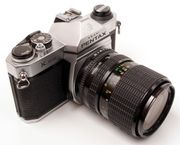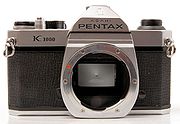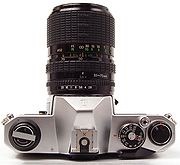
Pentax K1000
Encyclopedia



135 film
The term 135 was introduced by Kodak in 1934 as a designation for cartridge film wide, specifically for still photography. It quickly grew in popularity, surpassing 120 film by the late 1960s to become the most popular photographic film format...
, single-lens reflex
Single-lens reflex camera
A single-lens reflex camera is a camera that typically uses a semi-automatic moving mirror system that permits the photographer to see exactly what will be captured by the film or digital imaging system, as opposed to pre-SLR cameras where the view through the viewfinder could be significantly...
(SLR) camera, manufactured by Asahi Optical Co., Ltd.
Pentax
Pentax is a brand name used by Hoya Corporation for its medical-related products & services and Pentax Ricoh Imaging Company for cameras, sport optics , etc. Hoya purchased and merged with the Japanese optics company on March 31, 2008. Hoya's Pentax imaging business was sold to Ricoh Company, Ltd...
from 1976 to 1997, originally in Japan
Japan
Japan is an island nation in East Asia. Located in the Pacific Ocean, it lies to the east of the Sea of Japan, China, North Korea, South Korea and Russia, stretching from the Sea of Okhotsk in the north to the East China Sea and Taiwan in the south...
. It uses a horizontal travel, rubberized silk cloth focal plane shutter with a speed range of 1/1000 second to 1 second, along with Bulb and a flash X-sync of 1/60 second. It is 91.4 millimetre
Millimetre
The millimetre is a unit of length in the metric system, equal to one thousandth of a metre, which is the SI base unit of length....
s tall, 143 mm wide, and 48 mm deep, and weighs 620 gram
Gram
The gram is a metric system unit of mass....
s. The body was finished in black leather with chrome trim only, although early production Pentax K1000 SE bodies had brown leather with chrome trim.
The introductory US list price for the K1000 body with SMC Pentax 55 mm f/2 lens was $299.50. In 1983, a K1000 with SMC Pentax-M 50 mm f/2 lens listed for $220; in 1988, the body only was $210, but $290 with SMC Pentax-A 50 mm f/2; in 1993, the body only was $263. The body was priced at $315 in 1994 and remained there until discontinued. Note that SLRs usually sold for 30 to 40 percent below list price.
The K1000 is the simplest member of Asahi Optical's Pentax K-series SLRs, whose other members are the Pentax K2, KM, and KX, all introduced in 1975, and the K2 DMD (1976). All have the same basic body design, but with differing feature levels, internal electronics, and external controls and cosmetics.
The K1000's extraordinary longevity makes it a historically significant camera. The K1000's inexpensive simplicity was a great virtue and earned it an unrivaled popularity as a basic but sturdy workhorse. The Pentax K1000 eventually sold over three million units.
Features
The K1000 is an almost all metal, mechanically (springs, gears, levers) controlled, manual-focus SLR with manual exposure control. It was completely operable without batteries. It only needed batteries (one A76 or S76, or LR44LR44 battery
LR44 is the IEC designation for an alkaline 1.5 volt button cell, commonly used in small LED flashlights, digital thermometers, calculators, calipers, watches, clocks, toys and laser pointers....
or SR44) for the light metering information system. This consisted of a center-the-needle exposure control system using a galvanometer
Galvanometer
A galvanometer is a type of ammeter: an instrument for detecting and measuring electric current. It is an analog electromechanical transducer that produces a rotary deflection of some type of pointer in response to electric current flowing through its coil in a magnetic field. .Galvanometers were...
needle pointer moving between vertically arranged +/– over/underexposure markers at the right side of the viewfinder to indicate the readings of the built-in full-scene averaging, cadmium sulfide (CdS) light meter
Light meter
A light meter is a device used to measure the amount of light. In photography, a light meter is often used to determine the proper exposure for a photograph...
versus the actual camera settings. The meter did not have a true on/off switch and the lens cap needed to be kept on the lens to prevent draining the battery when the K1000 was not in use.
The viewfinder also had a focusing screen with a microprism spot focusing aid. The Pentax K1000 SE substituted a split image rangefinder plus microprism collar focusing screen. The K1000 SE is otherwise identical to the regular K1000, except that the SE's from the first few years of production used brown leather instead of black.

Pentax K mount
The Pentax K mount, sometimes referred to as the "PK mount", is a lens mount standard for mounting interchangeable photographic lenses to 35 mm single-lens reflex cameras. It was created by Pentax in 1975, and has been used by all Pentax 35 mm and digital SLRs since...
, introduced in 1975 with the Pentax K-series SLRs. This included the K-A mount lenses introduced in 1983. Manual focus lenses made by Asahi Optical were the SMC Pentax, SMC Pentax-M and SMC Pentax-A types.
In addition, almost all lenses with the Pentax K-AF and K-AF2 autofocus lens mounts (introduced 1987 and 1991, respectively) would also work in manual focus mode. The exceptions are Pentax's newest SMC-Pentax FA J (1997) and SMC-Pentax DA (2004) types, which lack an aperture control ring. They will mount on the K1000, but have restricted functionality. Asahi Optical sold the Mount Adapter K to allow their older Takumar screw mount lenses (see below) to be used on K mount cameras (with limitations). In 2006, Pentax said that it had manufactured more than 24 million lenses over fifty years that could provide at least some functionality on the K1000. The number of independently manufactured Pentax-compatible lenses is also huge, but indeterminate.
Except for having an enormous variety of lenses with the popular K mount to choose from, the K1000 had fewer features compared to higher level SLRs of the mid 1970s. It had a flash synchronization speed of 1/60th second, a sleeve-bushing equipped shutter and film advance mechanism, no self timer, no depth-of-field preview, no mirror lockup, no interchangeable focusing screens, no motor drive
Motor drive
A motor drive, in the field of photography, is a powered film transport mechanism. Historically, film loading, advancing, and rewinding were all manually driven functions...
option, and no autoexposure. It was an all-manual camera.
The K1000 did accept any non-dedicated hot shoe mounted or PC terminal X-sync electronic flash for guide number manual or flash mounted sensor automatic exposure control. The Vivitar
Vivitar
Vivitar Corporation was a manufacturer, distributor and marketer of photographic and optical equipment originally based in Oxnard, California. Since 2008 the Vivitar name serves as Sakar International's photographic and optical equipment brand.-Products:...
283 (guide number 120, ASA 100/feet; 37, DIN 21/meters), favored by many photographers for the same reasons as the K1000, had an even longer life span of 1974-2004. The K1000 was also old enough to use flash bulbs, with a maximum synchronization speed of 1/30th second.
Overall, the K1000 can be described as the reincarnation of the landmark Asahi (Honeywell
Honeywell
Honeywell International, Inc. is a major conglomerate company that produces a variety of consumer products, engineering services, and aerospace systems for a wide variety of customers, from private consumers to major corporations and governments....
in the USA) Pentax Spotmatic
Pentax Spotmatic
The Pentax Spotmatic is a range of 35mm single-lens reflex cameras manufactured by the Asahi Optical Co. Ltd., later known as Pentax Corporation, between 1964 and 1976. The original 1964 Spotmatic was one of the first SLRs to offer a through-the-lens exposure metering system, initially using...
SLR of 1964 with open aperture metering in a K-series body.
Design History
Beginning in 1975, there was a complete overhaul of Asahi Optical's Pentax SLR line when the first of the Pentax K-series SLRs were introduced - the Pentax K2, KM and KX. The SMC Pentax K mount lenses were introduced at the same time. The Pentax K1000 and K2 DMD followed in 1976. The K2/K2 DMD was the top-of-the-line model with aperture priority; the KX, the full-featured manual mechanical model; the KM, the basic manual mechanical model. The 1000 in the K1000's name was a direct reference that its top shutter speed was superior to Asahi Optical's previous bottom-of-the-line Pentax Spotmatic SP 500 of 1971. The spartan viewfinder had 91% coverage.The 1970s and 1980s were an era of intense competition between the major SLR brands: Pentax, Nikon
Nikon
, also known as just Nikon, is a multinational corporation headquartered in Tokyo, Japan, specializing in optics and imaging. Its products include cameras, binoculars, microscopes, measurement instruments, and the steppers used in the photolithography steps of semiconductor fabrication, of which...
, Canon
Canon Inc.
is a Japanese multinational corporation that specialises in the manufacture of imaging and optical products, including cameras, camcorders, photocopiers, steppers and computer printers. Its headquarters are located in Ōta, Tokyo, Japan.-Origins:...
, Minolta
Minolta
Minolta Co., Ltd. was a Japanese worldwide manufacturer of cameras, camera accessories, photocopiers, fax machines, and laser printers. Minolta was founded in Osaka, Japan, in 1928 as . It is perhaps best known for making the first integrated autofocus 35mm SLR camera system...
and Olympus. Between 1975 and 1985, there was a dramatic shift away from heavy all-metal manual mechanical camera bodies to much more compact bodies with integrated circuit (IC) electronic automation. In addition, because of rapid advances in electronics, the brands continually leap frogged each other with models having new or more automatic features. The industry was trying to expand.
Against this backdrop, Asahi Optical continued its use of 42 mm diameter, Universal M42 screw lens mount
M42 lens mount
The M42 lens mount is a screw thread mounting standard for attaching lenses to 35 mm cameras, primarily single-lens reflex models. It is more accurately known as the M42 × 1 mm standard, which means that it is a metric screw thread of 42 mm diameter and 1 mm thread pitch...
(often called the Pentax screw mount). The mount type was introduced by the German KW Praktica
Praktica
Praktica is a brand of camera manufactured by Pentacon in Dresden in eastern Germany, formerly within the GDR prior to reunification. Pentacon is the modern-day successor to Dresden camera firms such as Zeiss Ikon, and for many years Dresden was the world's largest producer of cameras...
or Zeiss-Dresden Contax S SLRs circa 1948) in its Pentax Spotmatic
Pentax Spotmatic
The Pentax Spotmatic is a range of 35mm single-lens reflex cameras manufactured by the Asahi Optical Co. Ltd., later known as Pentax Corporation, between 1964 and 1976. The original 1964 Spotmatic was one of the first SLRs to offer a through-the-lens exposure metering system, initially using...
SLR and Takumar lens lineages.
There was another overhaul of Asahi Optical's Pentax line beginning in 1976 when the M-series SLRs and SMC Pentax-M lenses came out, starting with the aperture priority only Pentax ME
Pentax ME
The Pentax ME was an aperture priority automatic camera, with an electronic focal plane shutter from 8 s to 1/1000 s, synchronized at 1/100 s. The shutter curtains were metal and had a vertical movement. There was no shutter dial, and the camera could not be used in manual mode,...
. The ME introduced an entirely new chassis and was very compact: 82.5 mm height, 131 mm width, 49.5 mm depth and 460 g weight. The M-series remained among the smallest and lightest full frame 35 mm film SLRs ever made. Asahi Optical also redesigned their lenses to be more compact, although the SMC Pentax-M lenses generally kept the optical formulae of the SMC Pentax lenses.
The K1000 was the only K-series SLR to survive the M-series changeover. It also survived the dramatic electronic growth of the M-series in the wake of the 1976 introduction of the landmark Canon AE-1
Canon AE-1
The Canon AE-1 is a 35 mm single-lens reflex film camera for use with interchangeable lenses. It was manufactured by Canon Camera K. K. in Japan from April 1976 to 1984. It uses an electronically controlled, electromagnet horizontal cloth focal plane shutter, with a speed range of 2 to 1/1000...
, the autofocus (AF) SLR camera revolution following the landmark Minolta Maxxum 7000
Minolta Maxxum 7000
The Minolta MAXXUM 7000 35mm SLR camera was introduced in 1985. It marked a significant milestone in photography as it was the first camera to feature both integrated autofocus and motorised film advance, the standard configuration for later amateur and professional single lens reflex...
in 1985 and the point-and-shoot (P/S) revolution following the confluence of cheap microchip electronics, high speed film and small aperture zoom lenses circa 1990.
The K1000 gained a unique popularity and sold well for many years as its lack of features came to be regarded an important feature in and of itself. Its spartan nature, without autoexposure or autofocus, meant a sturdy and reliable camera for a low price. The K1000 became highly recommended for student photographers.
Production was not ended until 1997 when manufacturing costs of its older design and supply of its mechanical and electronic parts (especially precision analogue microgalvanometers for the light meter) finally became untenable. It was replaced by the highly computerized Pentax ZX-M (also called MZ-M) in 1998.
Changes
Production of the largely hand assembled camera was moved from Japan, first to Hong Kong in 1978 and then to China in 1990, to keep labor costs down. The "Asahi" name and "AOCo" logo was removed from the pentaprism cover to de-emphasize the company name in keeping with the rest of the "Pentax" line. The meter components changed as Asahi Optical searched for suitable supplies. The metal in the wind shaft was downgraded from steel. Cheaper plastic was substituted for the originally aluminum top and bottom plates and aluminum and steel film rewind assembly. Note that the use of lighter plastic lowered the weight of the Chinese-assembled K1000s to 525 g.External links
- Nakamura, Karen (2005). Asahi Pentax K1000. PhotoEthnography.com's Classic Cameras, retrieved on November 17, 2005.
- Matt Denton's K1000
- Bojidar Dimitrov's Pentax K-Mount Page
- Manual available for download from the Pentax site (black and white).
- Manual Cameras: K1000
- The Other Martin Taylor: In praise of the humble K1000

